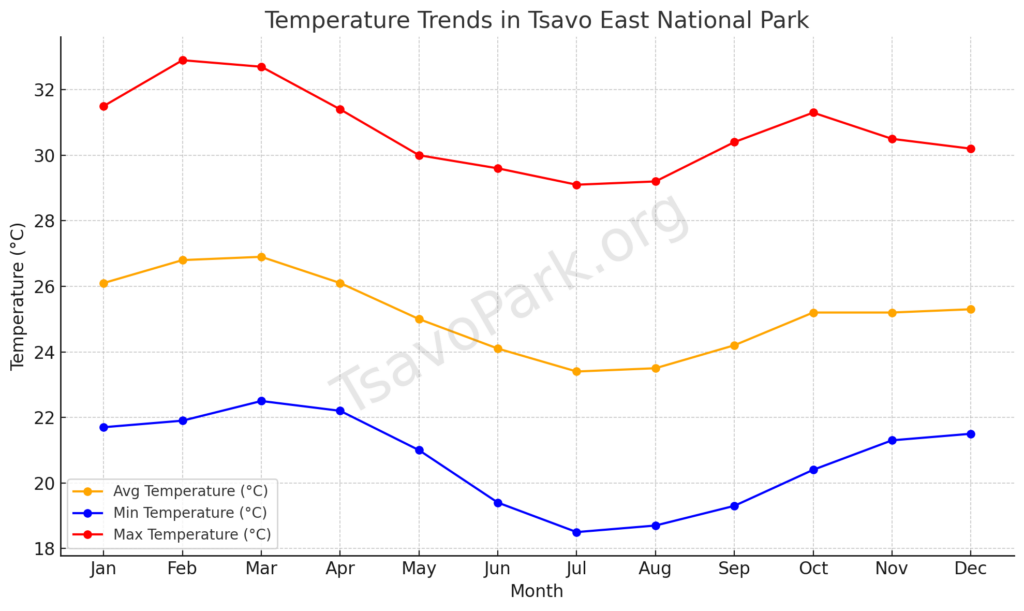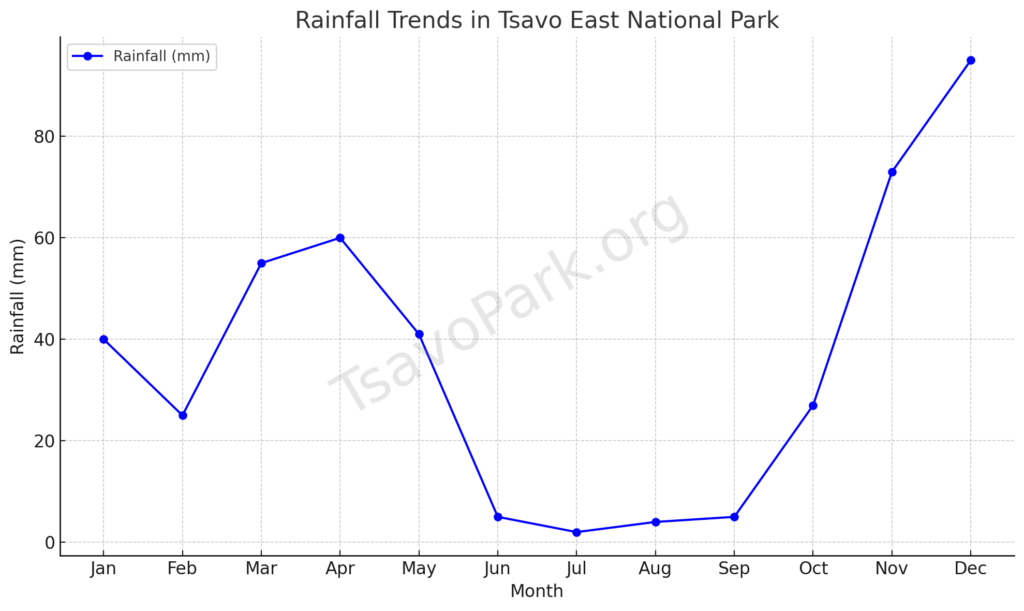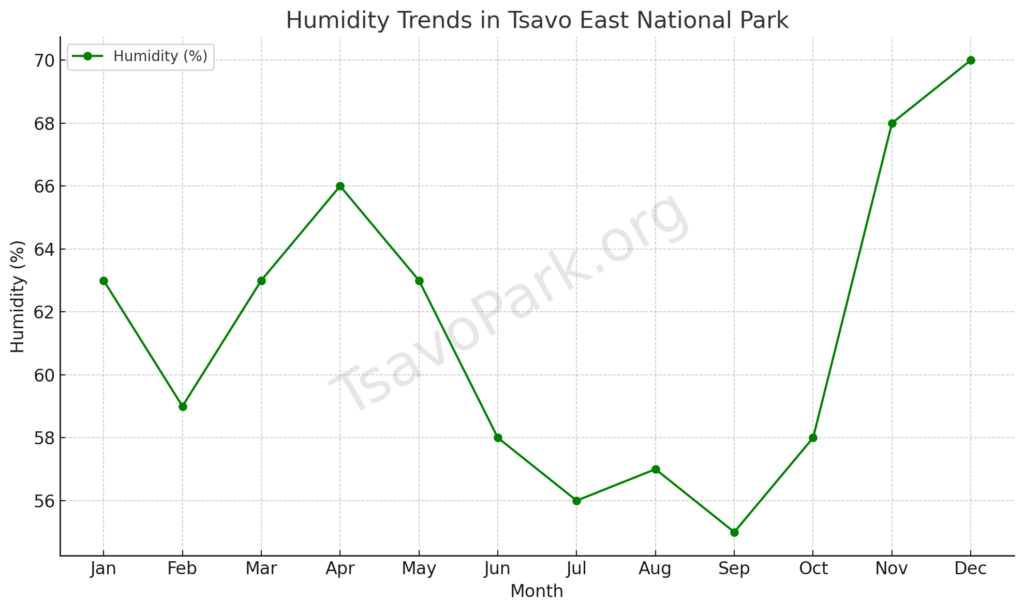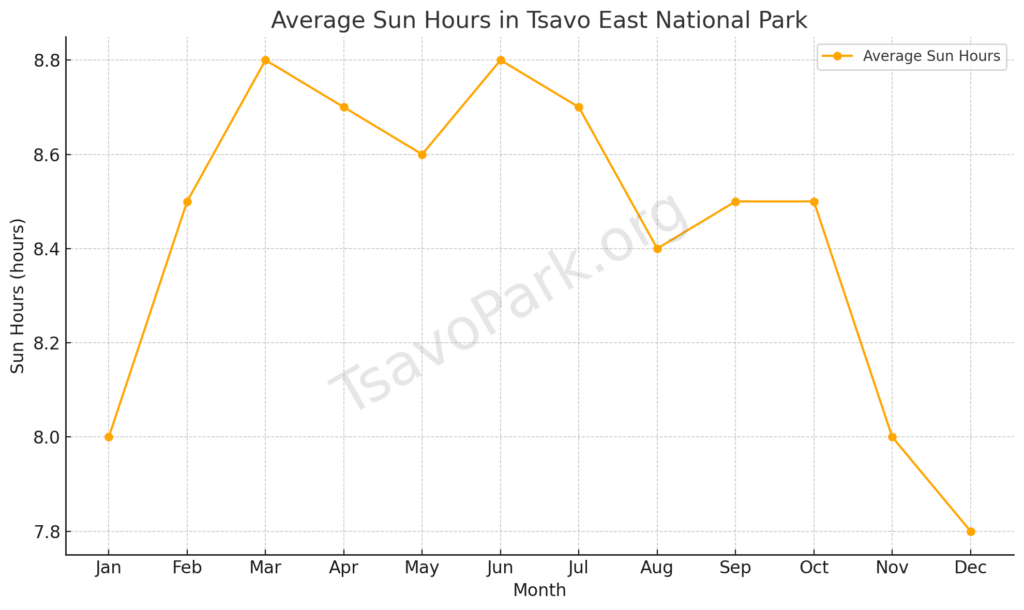The weather in Tsavo East National Park plays a crucial role in determining the best time to visit, the type of wildlife you’ll see, and even the park’s conservation efforts. Understanding Tsavo East’s climate is essential for planning an unforgettable safari experience while also being mindful of how weather patterns influence the park’s ecosystems. Below, we offer an expert breakdown of Tsavo East’s weather and actionable tips on how you can contribute to conservation while visiting.
1. Tsavo East Weather: What to Expect Year-Round
Tsavo East has a tropical climate, characterized by distinct wet and dry seasons. While the park is accessible year-round, the weather can significantly influence the type of safari experience you have.
General Weather Patterns:
- Dry Season: June to October
- Wet Season: November to May (with short rains from November to December and long rains from March to May)
During the dry season, you can expect hot days and cooler nights, while the rainy season brings greener landscapes, but some roads may become difficult to navigate.
Conservation Insight:
- Impact on Wildlife: The dry season forces animals to congregate around waterholes, making it easier to spot large herds of elephants, buffaloes, and predators. During the wet season, the park blooms with new vegetation, offering better opportunities for birdwatching and observing young wildlife.
Tip: Contribute to water conservation efforts by visiting during the dry season and supporting projects aimed at maintaining vital water sources for wildlife. Many lodges and organizations in Tsavo East contribute to building and preserving waterholes, especially during droughts.
2. Best Time to Visit Tsavo East National Park
The ideal time to visit Tsavo East largely depends on what you want to experience.
Best Time for Wildlife Viewing:
- Dry Season (June to October): Animals are easier to spot as they gather around scarce water sources. The dry vegetation offers less cover, making wildlife more visible.
Best Time for Birdwatching and Green Landscapes:
- Wet Season (November to May): Tsavo East comes alive with lush vegetation, and migratory birds arrive, making this the perfect time for birdwatchers. You’ll see newborn animals during this time, adding to the charm.
Conservation Insight:
- Drought and Wildlife Migration: The dry season places stress on Tsavo’s ecosystems, and wildlife must travel farther for water. By visiting during this period and supporting conservation projects that maintain waterholes, you help protect the wildlife that relies on these crucial resources.
Tip: Choose eco-friendly lodges that use rainwater harvesting and contribute to the conservation of the park’s scarce water resources.
3. How to Plan a Safari During Tsavo East’s Rainy Season
The rainy season in Tsavo East (March to May and November to December) is often overlooked by tourists but can provide a unique and rewarding experience.
Advantages of Visiting During the Rainy Season:
- Fewer Crowds: With fewer visitors, you’ll enjoy a more peaceful and intimate safari experience.
- Lush Scenery: The park transforms into a green paradise, making it ideal for photography and nature walks.
- Lower Prices: Accommodation and safari prices are generally lower during the rainy season, offering a more budget-friendly option.
Challenges of the Rainy Season:
- Muddy Roads: Some roads may become impassable, and game drives can be more challenging.
- Wildlife Dispersal: With ample water sources, animals spread out, making sightings less predictable.
Conservation Insight:
- Supporting Infrastructure: The rainy season helps replenish water sources, but flooding can damage park infrastructure like roads and bridges. Contribute to park maintenance efforts by supporting local initiatives that repair damaged roads and enhance park facilities.
Tip: Bring biodegradable gear such as eco-friendly rain jackets and waterproof boots to minimize your environmental footprint while traveling during the wet season.
4. What to Expect During the Dry Season in Tsavo East
The dry season (June to October) is the most popular time to visit Tsavo East due to its predictability and high wildlife visibility.
Key Highlights of the Dry Season:
- Wildlife Concentration: Animals gather around the remaining waterholes, making it easier to spot large herds of elephants, buffaloes, and big cats like lions and leopards.
- Easier Navigation: Roads are more accessible, and there are fewer challenges in reaching remote parts of the park.
Conservation Insight:
- Water Scarcity: The dry season exacerbates water shortages for wildlife. Support sustainable tourism operators who contribute to water-saving efforts within the park and engage in wildlife conservation projects that help mitigate the effects of drought on Tsavo’s animals.
Tip: Carry reusable water bottles and minimize water use during your stay to reduce your environmental impact.
5. Understanding Tsavo East’s Temperatures
Tsavo East’s temperatures can vary significantly, especially between day and night.
Typical Temperatures:
- Daytime: 27°C to 32°C (80°F to 90°F)
- Nighttime: 15°C to 20°C (59°F to 68°F)
The park is generally hot, but early mornings and evenings can be quite cool, especially during the dry season.
Conservation Insight:
- Adaptation of Wildlife: The fluctuating temperatures influence animal behavior, especially in the early morning and late afternoon when they are more active. Your responsible tourism helps fund efforts to study and monitor wildlife adaptation to changing climate patterns in the park.
Tip: Wear lightweight, eco-friendly clothing during the day and bring warmer layers for cooler nights. Supporting lodges that practice energy conservation through solar heating can help reduce energy consumption during your stay.
6. Tsavo East’s Climate: What Every Visitor Should Know
Tsavo East experiences a semi-arid climate, which means it has hot, dry conditions for much of the year with short rainy periods.
Climatic Influences:
- Rainfall: 200mm to 700mm per year, with higher rainfall in the southern parts of the park.
- Humidity: Lower during the dry season and higher during the wet season.
Conservation Insight:
- Climate Change and Tsavo: As climate change impacts weather patterns, Tsavo East’s ecosystems face increasing challenges such as prolonged droughts and changing migration patterns. By choosing eco-conscious safari operators, you can contribute to climate resilience projects in the park, such as reforestation and the development of wildlife corridors that help animals adapt to changing environments.
Tip: When planning your safari, choose operators and lodges that are committed to sustainability practices, such as using renewable energy sources and contributing to local conservation initiatives.
Month-by-Month Weather Insights and Advice for Visiting Tsavo East National Park
The temperature chart reveals a fairly consistent warm climate throughout the year in Tsavo East National Park. The average temperatures range between 23.4°C (74.1°F) in July and 26.9°C (80.4°F) in March, with noticeable peaks in February and March, making these the hottest months. Minimum temperatures hover around the mid-60s°F to low-70s°F, while maximum temperatures can reach as high as 32.9°C (91.2°F) in February. These consistent warm conditions make it ideal for year-round safaris, though the cooler months (June to August) are preferred for more comfortable game drives.

Here’s a table showing the temperature trends throughout the year in Tsavo East National Park, including average, minimum, and maximum temperatures:
| Month | Avg. Temperature (°C / °F) | Min. Temperature (°C / °F) | Max. Temperature (°C / °F) |
|---|---|---|---|
| January | 26.1°C (79°F) | 21.7°C (71°F) | 31.5°C (88.6°F) |
| February | 26.8°C (80.3°F) | 21.9°C (71.5°F) | 32.9°C (91.2°F) |
| March | 26.9°C (80.4°F) | 22.5°C (72.5°F) | 32.7°C (90.9°F) |
| April | 26.1°C (79°F) | 22.2°C (72°F) | 31.4°C (88.5°F) |
| May | 25.0°C (77°F) | 21.0°C (69.8°F) | 30.0°C (86.1°F) |
| June | 24.1°C (75.3°F) | 19.4°C (66.9°F) | 29.6°C (85.3°F) |
| July | 23.4°C (74.1°F) | 18.5°C (65.4°F) | 29.1°C (84.3°F) |
| August | 23.5°C (74.2°F) | 18.7°C (65.7°F) | 29.2°C (84.6°F) |
| September | 24.2°C (75.6°F) | 19.3°C (66.8°F) | 30.4°C (86.7°F) |
| October | 25.2°C (77.3°F) | 20.4°C (68.8°F) | 31.3°C (88.3°F) |
| November | 25.2°C (77.4°F) | 21.3°C (70.3°F) | 30.5°C (86.9°F) |
| December | 25.3°C (77.6°F) | 21.5°C (70.7°F) | 30.2°C (86.4°F) |
This table provides a clear view of temperature fluctuations throughout the year in Tsavo East, highlighting both the cooler months and the hotter months.
- January:
- Hot and Dry with average temperatures of 26.1°C and low rainfall. Humidity is around 63% with plenty of sunshine (8 hours daily).
- Advice: Ideal for wildlife viewing as animals gather near water sources. Early morning or late afternoon safaris are best to avoid the heat.
- February:
- Very Hot and Dry with temperatures reaching 32.9°C and minimal rainfall. Humidity drops to 59%.
- Advice: Great for game viewing but plan for hot conditions. Sunscreen and hydration are essential.
- March:
- Warm with Onset of Short Rains, temperatures average 26.9°C. Rainfall starts increasing with 55 mm, and humidity rises to 63%.
- Advice: This is a transitional month with scattered rains but good game viewing. Expect some muddy roads but manageable conditions.
- April:
- Wet and Green, with long rains dominating. Temperatures hover around 26.1°C with high humidity (66%) and 60 mm of rainfall.
- Advice: The park transforms into a lush landscape. However, game drives may be challenging due to muddy roads. Good for birdwatching and fewer tourists.
- May:
- Cool and Wet as rains continue, with an average temperature of 25°C. Humidity remains high at 63%, and rainfall is around 41 mm.
- Advice: Roads can still be muddy, and wildlife sightings are less predictable. It’s a good time for photographers with lush, green backdrops.
- June:
- Start of Dry Season, temperatures cool slightly to 24.1°C, and rainfall drops to just 5 mm. Humidity is moderate at 58%.
- Advice: A perfect month for game drives as wildlife congregates around waterholes, and the park dries out. Excellent for long, uninterrupted safari days.
- July:
- Cool and Dry, with temperatures averaging 23.4°C and almost no rainfall. Humidity drops to 56%, and sunshine lasts 8.7 hours.
- Advice: This is an excellent month for wildlife viewing in comfortable conditions. Consider layering clothing for cooler early mornings and evenings.
- August:
- Mild and Dry, with temperatures around 23.5°C, very low rainfall (4 mm), and humidity at 57%.
- Advice: A prime time to visit, with dry, pleasant conditions and active wildlife. Ideal for photography and extended game drives.
- September:
- Warming Up and Dry, with temperatures rising to 24.2°C. Rainfall remains low at 5 mm, and sunshine is consistent at 8.5 hours.
- Advice: Excellent for game viewing as the dry conditions persist. A good time to explore more remote areas of the park.
- October:
- Warm and Dry, with temperatures reaching 25.2°C and moderate rainfall starting at 27 mm. Humidity is around 58%.
- Advice: This month marks the end of the dry season, making it a good time for game drives before the rains return. Plan for mixed conditions.
- November:
- Start of Short Rains, with temperatures averaging 25.2°C. Rainfall increases to 73 mm, and humidity rises to 68%.
- Advice: The park begins to green again, making it ideal for birdwatching. However, roads may start getting muddy, and wildlife disperses as water sources replenish.
- December:
- Warm with Scattered Rains, temperatures remain around 25.3°C, and rainfall peaks at 95 mm. Humidity is high at 70%.
- Advice: A beautiful mix of sun and rain, perfect for seeing a greener landscape and abundant wildlife. Prepare for occasional rain showers but overall pleasant conditions.
This holistic guide combines temperature, humidity, rainfall, and sunshine to offer tailored advice for visiting Tsavo East throughout the year, helping you plan your safari experience at the best time for your preferences.
Rainfall in Tsavo East
Rainfall patterns are defined by two rainy seasons: the long rains from March to May and the short rains in November and December. The wettest months are November and December, receiving 73 mm and 95 mm of rain, respectively. The dry season spans from June to September, with very minimal rain, especially in July and August, which see almost no rainfall. This stark contrast between wet and dry seasons plays a significant role in wildlife behavior, with animals congregating around water sources during the dry season.

Humidity in Tsavo East
The humidity chart shows a fairly moderate and predictable pattern. Humidity levels are highest during the rainy months, peaking at 70% in December. The driest months, July and August, see humidity drop to around 56-57%, offering comfortable conditions for outdoor activities. These shifts in humidity are closely tied to the park’s rainy and dry seasons, impacting both wildlife activity and visitor comfort, with the dry months generally being more pleasant for safaris.

Sun Hours in Tsavo East
The average sun hours remain fairly consistent throughout the year, offering 7.8 to 8.8 hours of sunlight daily. The sunniest months are February to June, with 8.7 to 8.8 hours of sunshine per day, making it perfect for extended game drives and photography. Even during the wettest months (November and December), the park enjoys a generous amount of sunlight, around 8 hours per day, ensuring plenty of daylight for safari activities despite the rains.

Actionable Conservation Tips for Tsavo East Visitors:
- Choose Sustainable Lodges: Opt for accommodations that use solar power, rainwater harvesting, and other eco-friendly practices.
- Minimize Your Water Usage: Be mindful of water consumption, especially during the dry season when water is scarce.
- Support Local Conservation Projects: Contribute to initiatives that focus on water conservation, wildlife protection, and habitat restoration.
- Travel Responsibly: Stick to designated routes to avoid disrupting the ecosystem and respect wildlife by keeping a safe distance.
- Use Eco-Friendly Gear: Bring reusable water bottles, eco-friendly sunscreen, and biodegradable toiletries to reduce plastic waste and pollution.
What the weather trends over the years in Tsavo Tell Us
The trends over the years in Tsavo East National Park indicate significant changes driven by both natural cycles and human-induced factors such as climate change. According to research published by the Kenya Wildlife Service (KWS) and studies such as the UNEP’s Global Environmental Outlook (GEO), temperature increases and rainfall variability are becoming more pronounced across the Tsavo ecosystem.
Temperature Trends:
Over the past few decades, global warming has resulted in a steady increase in temperatures in Tsavo and other East African regions. A study by Ogutu et al. (2016) highlights that average temperatures in the area have risen by approximately 0.5°C since the mid-20th century. This gradual warming has led to longer dry periods and more intense heat during the dry season, affecting both wildlife behavior and vegetation patterns.
Rainfall Trends:
Rainfall variability has been a growing concern in Tsavo East, with both extended dry spells and more intense but irregular rainfalls being observed. Research by Herrero et al. (2010) points out that while the region is experiencing unpredictable rainfall patterns, the frequency of extreme weather events such as floods and prolonged droughts has increased. These erratic rains have altered the timing of water availability, causing stress on both wildlife and the park’s ecosystems.
Impacts on Wildlife and Ecosystems:
As a result of these climatic changes, key species such as elephants and herbivores are altering their migration patterns to cope with the extended dry seasons, according to the African Conservation Centre. Additionally, pasture quality and water availability have diminished, leading to higher mortality rates among wildlife during droughts, a trend observed by Western et al. (2020). Moreover, the 2016 drought in Tsavo was particularly harsh, resulting in the death of almost 400 elephants due to water scarcity, as documented in the National Drought Management Authority (NDMA) reports.
Future Outlook:
Looking forward, researchers predict that climate extremes in the Tsavo ecosystem will continue to intensify. A World Bank report (2021) on climate risks in Kenya suggests that both increased temperatures and high rainfall variability will persist, posing ongoing challenges for conservation efforts in the region.
In summary, expert research indicates that Tsavo East is experiencing the effects of climate change, with increased temperatures and rainfall variability influencing the park’s weather patterns, wildlife behavior, and overall ecosystem health. Conservation strategies will need to adapt to these changes to ensure the long-term survival of this vital ecosystem.
Conclusion
The weather in Tsavo East National Park not only shapes your safari experience but also plays a vital role in the conservation of its ecosystems. By understanding the park’s climate and planning accordingly, you can enjoy a fulfilling adventure while actively contributing to the preservation of its wildlife and natural beauty. Whether you visit during the dry season to see wildlife congregate at waterholes or explore the lush landscapes during the rainy season, you have the opportunity to make a positive impact on this extraordinary environment. Plan your eco-friendly safari today and become part of the conservation solution in Tsavo East!
